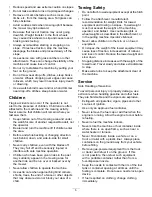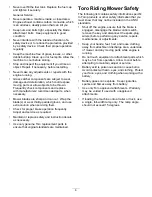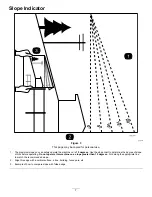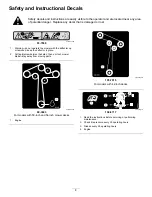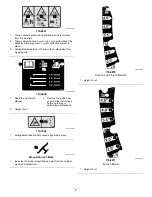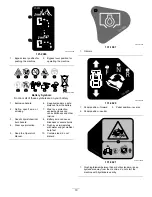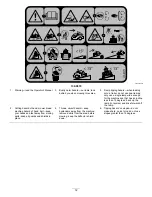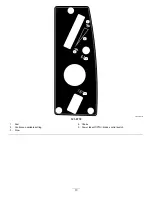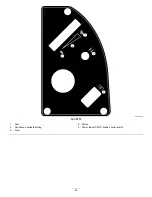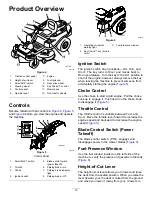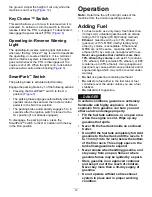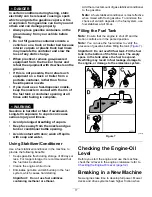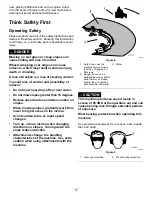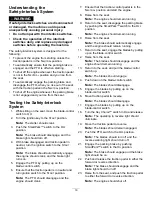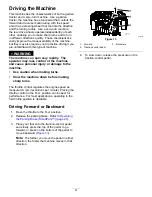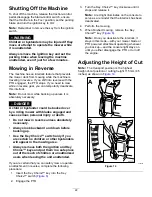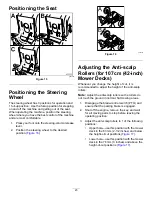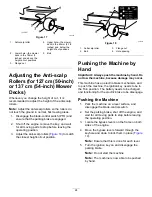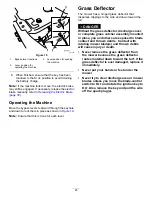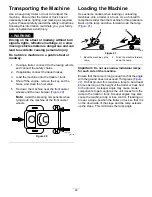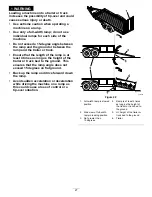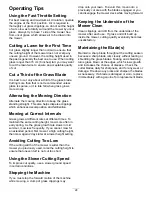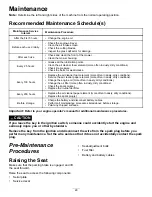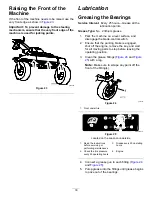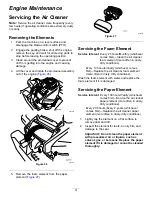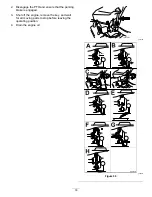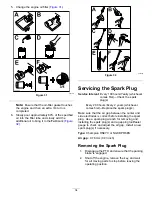
Understanding the
Safety-Interlock System
WARNING
If safety-interlock switches are disconnected
or damaged, the machine could operate
unexpectedly causing personal injury.
•
Do not tamper with the interlock switches.
•
Check the operation of the interlock
switches daily, and replace any damaged
switches before operating the machine.
The safety-interlock system is designed for the
following:
•
To prevent the engine from starting unless the
traction pedal is in the N
EUTRAL
position.
•
To automatically ensure that the parking brake is
engaged and the PTO is off when starting.
•
To shut off the engine whenever the traction pedal
is not in the N
EUTRAL
position and you rise from
the seat.
•
To automatically engage the parking brake and
disengage the PTO, when you rise out of the seat
with the traction pedal in the N
EUTRAL
position.
•
To shut off the engine whenever the parking brake
is not engaged and you rise from the seat.
Testing the Safety-Interlock
System
1.
While sitting on the seat, move the blade-control
switch to O
FF
.
2.
Turn the ignition key to the S
TART
position.
Note:
The starter should crank.
3.
Push the SmartPark™ switch to the O
FF
position.
Note:
The brake should disengage, and the
brake light should turn off.
4.
With brake disengaged and traction pedal in
neutral, turn the ignition switch to the S
TART
position.
Note:
The brake should automatically engage,
the engine should crank, and the brake light
turns on.
5.
Engage the PTO by pulling up on the
blade-control switch.
6.
Ensure that the traction pedal is in neutral and
turn ignition switch to the S
TART
position.
Note:
The PTO should disengage and the
engine should crank.
7.
Ensure that the traction-control pedal is in the
N
EUTRAL
position and start the engine.
8.
Raise from the seat.
Note:
The engine should remain running.
9.
Return to the seat, disengage the parking brake
by pushing the SmartPark™ switch to the O
FF
position.
Note:
The engine should remain running.
10.
Raise from the seat.
Note:
The brake should automatically engage
and the engine should remain running.
11.
Return to the seat, engage the blades by pulling
up on the blade-control switch.
12.
Raise from the seat.
Note:
The blades should disengage and the
engine should remain running.
13.
Return to the seat, and pull the blade-control
switch up.
Note:
The blades should engage.
14.
Push down on the blade-control switch.
Note:
The blades should disengage.
15.
Engage the blades by pulling up on the
blade-control switch.
16.
Move traction pedal to reverse.
Note:
The blades should disengage.
17.
Engage the blades by pulling up on the
blade-control switch.
18.
Turn the Key Choice™ switch to O
N
and release.
Note:
The operating in reverse light should
illuminate.
19.
Move the traction pedal to reverse.
Note:
The blades should remain engaged.
20.
Push the PTO switch to the O
FF
position.
Note:
The blades should turn off and the
reverse warning light should turn off.
21.
Engage the parking brake by pushing
SmartPark™ switch to the O
N
position.
Note:
The brake should engage and the brake
light should be on.
22.
Push and release the traction pedal in either the
forward or reverse direction.
Note:
The brake should disengage and the
brake light should turn off.
23.
Raise from the seat, and push the traction pedal
to either the forward or reverse direction.
Note:
The engine should shut off.
19
Содержание TimeCutter SW 5000
Страница 52: ...Schematics g027754 Electrical Diagram Rev A 52 ...
Страница 53: ...Notes ...
Страница 54: ...Notes ...
Страница 55: ...Notes ...

